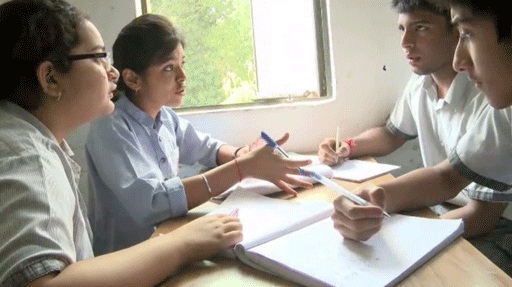3 Forming and managing project teams
In order to develop their collaborative and social skills, projects are usually best done by students working in small groups (Figure 1), although they can be done in pairs or by individuals. Four students is the usual optimum number for a project team. In bigger groups, each individual student’s contribution can be very small and it is not meaningful for them; in smaller groups, there can be too much for each individual student to complete. But ultimately, you need to decide the group size based on your class size, the resources available and the nature of the project.

Mixed gender groups are generally better than same-sex groups if your students are used to working in this way. The same is true for mixed ability groups. Avoid putting students who do not cooperate in the same group. You might also want to think about where the students live. If you are expecting your students to work on the project outside school, it might be helpful to group students who live near to each other. You would want to make sure that students who have difficulties with reading or writing are grouped with students who are proficient with these skills. The best group will be one where the students’ skills complement each other and where the students support each other. You should decide the groups before the lesson and then read out the groups or pin up the group list on the classroom wall or noticeboard.
Teams work best when each student has a specific role. Roles should be based on the roles that would be needed in the real world to complete the project. You will need to give students suggestions for the roles such as leader, researcher or recorder. Alternatively, students could each work on gathering information on one aspect of the topic and then work together on analysing and presenting it.
Case Study 1: Teacher Samsana begins a project
Teacher Samsana organises her students into project teams.
I decided that Class X was going to work on the chapter on sources of energy as a project. It was ambitious because if they are all here, there are 80 students in the class. There is a good chapter in the textbook, but we are on the outskirts of a large city, so to get access to the internet, you have to go into the city to an internet café. I started collecting information in boxes in the classroom and asked my students to gather information too. I printed some information from the internet one weekend and put it in the boxes.
I organised my students into groups of four. I tried to mix up the girls and boys, and I tried to take account of where they lived and their friends. I mixed the low and higher attainers, making sure that the weakest students were in a group with a friend who could help them. It took me quite a while, and when they got going I had to swap a few students. But I did this quietly because I did not want them to think that they could all move groups! There were unequal numbers of girls and boys, so two girls ended up in groups with three other boys. There were not happy, so I ended up with a group of boys and put the two girls together. I think being flexible was important. I realised that organising groups for project work can be difficult. I will watch them carefully while they are working and try and notice who works well together.
2 Finding information
